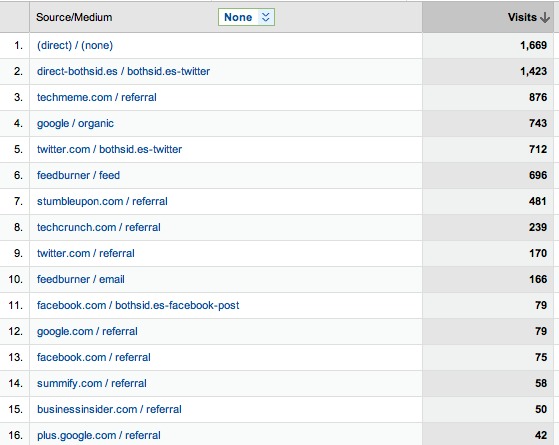Editor’s Note: This is a guest post by Mark Suster (@msuster), a 2x entrepreneur, now VC at GRP Partners. Read more about Suster at his Startup Blog, BothSidesoftheTable.
Most web publishers measure where their traffic is coming from using an analytics package such as Google Analytics, Omniture or Core Metrics.
These were good packages in the pre social media world at helping figure out who was driving your traffic.
Today they’re wrong. Terribly wrong. And figuring out who is referring your traffic is a very important part of determining how you allocate your marketing budgets. It is almost certain that Twitter is driving much more of your referrals than you think.
Possibly up to 4x as much.
Jonathan Strauss is the gentleman who did all the number crunching and has written an excellent post on why this is.
I’ve been a user of awe.sm (his product) before I invested in his company (disclosure) so the understatement of Twitter as a referral source is a problem I’ve known about for a long time. Let me give you the simple explanation.
 Take a look at the Google Analytics log for BothSidesofTheTable.com for yesterday. I had 8,502 visitors yesterday of which 1,669 are listed as “direct.” Direct traffic are people who typed in my URL directly. They weren’t “referred” by anybody.
Take a look at the Google Analytics log for BothSidesofTheTable.com for yesterday. I had 8,502 visitors yesterday of which 1,669 are listed as “direct.” Direct traffic are people who typed in my URL directly. They weren’t “referred” by anybody.
But look at the second line. This says “direct – bothsid.es / bothsid.es – twitter” and shows 1,423 referrals. Line 5 says twitter.com / bothsid.es – twitter” for 712 referrals and line 9 shows twitter.com for 170 people.
What does that mean?
awe.sm tracks all of my social media sharing behavior. What awe.sm does is it allows publishers to be able to track each individual share behavior to a level of granularity that no other campaign tracking tool I’m aware of allows.
In ordinary tracking line 2 would have shown up as “direct” traffic and I would have assumed that I was getting a lot more direct traffic than I really was. I would have assumed I was 36% direct and just 10% via Twitter when the reality is that I’m 20% direct and 27% via Twitter.
In fact, the actual Twitter referrals are generally up to 4x as much as people think is happening. And the same is almost certainly the same for most publishers in terms of understating referrals.
This is a problem because publishers might then under invest in Twitter campaigns relative to others because they don’t get “last mile attribution” right.
This happens with other marketing campaigns, too. Often you hear a radio ad, see a TV ad or read an article in a magazine and you type the results into Google to find out more details about the product or service. The problem is that marketers assume that Google drove the traffic. They did not. So you ramp down your TV or print campaigns and suddenly your search volume goes down.
Doh!
Last mile attribution is very important to understand marketing ROI. For the above problem the best company I know of is called Convertro. I’m not an investor in the company. But Jeff Zwelling is one of the most informed people on last-mile attribution with whom I’ve spoken.
And in social media the problem is even worse than I described. Twitter is an amazing generator of social hooks to websites. Some of that comes from Twitter.com or other Twitter clients. But since many other websites pull in Twitter data, including links, you don’t always know who is referring the traffic to you.
Case in point: LinkedIn. Many Tweets are now being sent to LinkedIn and then the publisher assumes that the source of the referral is LinkedIn. In some ways it is because that’s where your user engaged the content. But get rid of the Tweet and you get rid of the referral traffic in the same way as I described the loss when you cancel your TV commercial.
So when I see MG Siegler announce that LinkedIn is sending more traffic to TechCrunch than Twitter – I’m not so sure. I understand why he would think that – Google Analytics tells him so. But I’ll bet a hefty amount of LinkedIn clicks were originated on Twitter. And I’ll bet a whole lot of TechCrunch “direct” traffic is from Twitter.
With proper social media attribution you need to generate a unique URL for EACH share behavior. So if you click on a “Tweet this” button on a website to send an article to your friends, that link needs to be individual to you and to that exact share instance. By making the URL link unique to its point of generation you can then track it better as it spreads to other sites
And importantly when anybody else then shares the link to this site it maps out a “parent / child” link relationship. So if the original Tweet was on Twitter and then somebody builds a “Tweet this” from a product like LinkedIn, you can still tell that the original source of the the story was Twitter. Call it, “last mile social media attribution” and when you’re a brand spending money on products & marketing you need to know this.
They also cookie users so that we can better track who it was that drove viral adoption of campaigns. It could be that one influential person send a Tweet but he doesn’t have a lot of followers. If Ashton Kutcher follows that person and suddenly shares if with his 7 million followers it would start to snowball.
So there you have it. The story is never quite as simple as the data might lead you to believe.
Image courtesy of Fotolia.































Comment